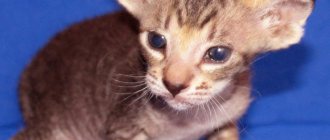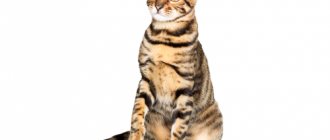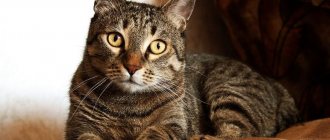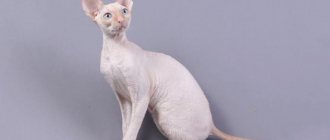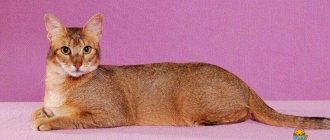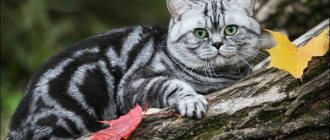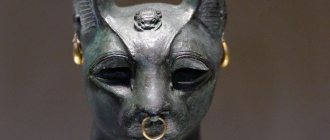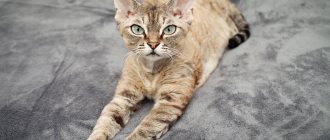The Peterbald, or whatever else this unusual breed is called, the St. Petersburg Sphynx, is a real mixture of grace and elegance along with exoticism.
The breeders who were breeding the breed mixed the genes of the Oriental breed and the Don Sphynx in its blood.
The result is a playful, balanced, graceful and somewhat shocking Peterbald breed.
Character of the Peterbald cat breed
The character of Peterbalds is actually exactly the same as that of all Sphynxes. They are very kind and friendly, able to easily find a common language with other inhabitants of the house.
They are very devoted to their owners, but get along well with all family members; they treat guests with suspicion, but they soon get used to it and treat them the same way as everyone else in the house.
- They do not like to be alone, so they follow their owner almost everywhere, require a lot of attention, but are not intrusive.
- If they see that the owner is busy, they will wait patiently until he has free time for them.
- They love to play; if there are other pets at home, they will try to flirt with them.
Health
The modern St. Petersburg Sphynx has good health and a well-developed immune system. When communicating with other animals or while walking, Peterbalds can contract a dangerous viral infection. It is important to follow the vaccination schedule:
- At 8-12 weeks, a comprehensive vaccination against panleukopenia, rhinotracheitis and calcivirosis is given.
- After changing teeth, the vaccine is re-administered in combination with an anti-rabies drug.
- Every next 12 months it is worth revaccinating and deworming.
The drugs “Narvak”, “Merial” and “Intervet” are considered high-quality products. The choice should be left to the treating veterinarian and not to vaccinate yourself.
Cohabitation
Although they get along well with virtually any other pet, some precautions need to be taken.
- For example, at the beginning of acquaintance, it is better to keep the cat away from larger animals, especially dogs. This will help avoid conflict.
- The breed is slightly jealous, so if the owner devotes more time to other pets than to her, she will try to show her dissatisfaction with the change in behavior.
The way out of the situation would be to pet the cat, talk to it tenderly, and give it new toys that it can play with.
Castration and sterilization
Some owners cannot decide to spay or neuter their Peterbald pet. They cannot imagine him on the operating table, they think that he will be in pain, and after the veterinarian’s intervention there may be health problems. In fact, castration of an animal is considered one of the safest and most popular operations. Thanks to her, owners get rid of the need to endure unpleasant moments associated with the animal’s sexual life and look for somewhere to place their offspring, and their pets become calmer and more affectionate. In addition, after surgery, the risk of developing some serious pathologies in animals is reduced.
Both castration and sterilization are surgical procedures whose purpose is to disrupt the reproductive function of an animal. Sterilization can be carried out in several ways. Almost all of them, while depriving the animal of the ability to reproduce, do not affect hormonal levels in any way. In other words, the owner will be spared the need to accommodate unwanted offspring, but the cat will still experience sexual desire. Therefore, the castration procedure is considered more popular.
The optimal age for castration is from 6 to 14 months. Surgery too early may contribute to growth retardation. Castration of both male and female cats takes very little time - from 5 to 15 minutes. The pet is under anesthesia for a short time, and blood loss can be called minimal. According to statistics, complications after castration occur in only 0.05% of animals.
Pet care
All Sphynx cats have increased thermoregulation because they lack fur. They need to generate more heat, so they spend more energy than breeds that have wool.
To replenish the energy supply, it is necessary to feed your pet with special, balanced food that will be able to saturate the animal with vitality.
There are ready-made foods on sale with increased energy value; these are the ones that are recommended to be given to your pet. In the winter season, you need to make sure that the cat has its own small warm house in which it will sleep.
- It should be taken into account that cat breeds without hair sweat, so they require more careful care.
- Their body needs to be wiped with wet wipes every day, and bathing procedures should be arranged every week using special shampoos.
- In the winter season, if you plan to transport a cat, you need to carefully wrap it in a warm towel, or put a special overall on it.
Otherwise, care is no different from other cat breeds; it is also necessary to monitor the cleanliness of the mouth and ears, the cleanliness of the eyes and nose.
How to choose a kitten
- Before purchasing a kitten, get to know the St. Petersburg Sphynx breed better, paying special attention to hairless cats. If the sticky, secretion-covered skin and the characteristic smell emanating from the “rubber bands” do not bother you, look for a reliable nursery.
- Commercial breeders often tailor their wards to the needs of buyers. In particular, instead of a hairless Peterbald, from such sellers you can purchase a shaved flock or a representative of any other variety. Before purchasing, make sure you are dealing with a professional or registered nursery.
- Color-pointed Sphynxes are born completely white, and the color on the tip of the nose, tail, ears and paws appears a few days after birth.
- In one litter, completely naked, flocked and brushed kittens can be born, but the animals acquire stable external features only by the age of two. As a result: when purchasing, you should be prepared for the fact that instead of a flocked pet you will get a flocked or velor-pointed cat.
- Carefully examine the kitten while it is sitting. If the St. Petersburg Sphynx's keel protrudes too much, this is most likely a consequence of subluxation of the sternum, which is regarded as a defect.
- Gently feel the tail of the Peterbald you like. It should be smooth, without creases, skin folds, knots and an empty leather pouch at the tip.
- A healthy Peterbald kitten's skin should not show signs of eczema or acne, although minor scratches from littermates' claws are acceptable.
- Breeders more often offer brush and velor Peterbalds as pets, reserving “gummy cats” for exhibitions. However, here too much depends on anatomy. If the brush/flock shows more oriental features, the panel of judges is more likely to award it a win than a “naked” one with flaws.
- When purchasing a naked Peterbald for further breeding, be especially careful. Sometimes the “boys” of this variety are sterile, and the “girls” may not lactate.
Varieties
Considering the description of the Peterbald Sphynx breed, it is worth noting that the breed has several varieties, each with its own characteristics in care and appearance, as well as in character.
Flock
This variety lacks mustaches and eyebrows, but they have a small coat of fur that does not exceed 2 mm.
The Peterbald with wool is also very popular; caring for it is a little easier, because almost the entire body is covered with a thin layer of hair.
Appearance of the Peterbald and its differences from the Don Sphynx
Judging by images from the Internet, cats from the city on the Neva are not much different from the Don Sphynxes. However, in real life, Peterbalds are much smaller and more sophisticated than their southern counterparts. In particular, the weight of the average “bald Petit” fluctuates between 3-5 kg, while the “Donetsk team” can increase their weight up to 7 kg.
Among other things, “St. Petersburgers” are characterized by outstanding grace, which brings them closer to Orientals, and less “folding” of the skin. If the Peterbald inherited the rough bones and plump shape of the “Donchak”, this can be considered as a serious exterior defect. Each breed has its own characteristics in the structure of the skull. For example, the head of the Don Sphynx has an exotic, almost alien outline, while the faces of Peterbalds are associated with the flat heads of snakes.
Head
Peterbalds have a wedge-shaped skull that widens from the nose towards the ears. The cat's muzzle is long, with a slightly convex profile and a flattened forehead.
Ears
The ear flap is large, wide at the base, continuing the wedge of the cat's muzzle.
Eyes
The eyes of the St. Petersburg Sphynx are almond-shaped and slanted. The traditional color of the iris is green, but for individuals with a pointed coat, bright blue eyes are acceptable.
Frame
The Peterbald's body is elongated, muscular, with an elegant silhouette. The neck is graceful and elongated. The chest is somewhat narrower than the hips.
Limbs
The legs of Peterbald cats are long, thin and perfectly straight. The animal’s paws are oval-shaped, with flexible, so-called “monkey” toes.
Tail
Long, whip-like, thin along its entire length, with a pointed tip.
Vibrissae
The standard cat whiskers of St. Petersburg Sphynxes are either absent as such or have a shortened, broken-curved design.
Skin and coat
A correct Peterbald's skin should be soft, loosely fitting the body, forming numerous folds on the head and a slightly smaller number on the body. By inheritance from the Don Sphynxes, the breed received the hairless gene, so the classic Peterbald is, in fact, a hairless cat, in some cases having sparse and short hair.
Varieties of St. Petersburg sphinxes
- Hairless (“gummi”, “gum cat”) - animals with a complete absence of hair. The skin of these cats feels like thin rubber to the touch. Another feature of hairless Peterbalds is intense skin secretions that form a thin layer of brownish plaque on the body.
- Flock - beardless and eyebrowless individuals with ultra-short silky hair (up to 2 mm) along the body.
- Velor – kittens with short or semi-long hair, which can disappear as they grow older, leaving small furry “islands” on their paws (socks, knee socks). In general, the wool of velor petriks is thicker than that of flock ones.
- Brush-pointed are individuals with a hairless or softly flocked body and thick, hard fur on the face, paws and tail.
- Brush - pets with hard/soft curled hair, fully or partially pubescent. As a brush cat grows older, it may become bald in the neck and back, but does not shed its hair completely.
It is worth mentioning separately about the straight-haired variety of Peterbalds or straight-haired dogs. These are animals that have not inherited the hairless gene and have classic cat coats and normal straight whiskers. Such individuals are not breeding animals, and in exceptional cases they can even be recommended for breeding, but they are significantly cheaper. By the way, in terms of body type, it is the straight-haired variety that is closest to its ancestor, the Oriental.
An important point: in addition to the listed types, St. Petersburg Sphynxes have several intermediate coat variants such as flock point, velor point and others, which can change into other varieties as the animal grows older. This feature greatly complicates the choice of a kitten, since it is almost impossible to predict what the pet will look like in adulthood.
Colors
The St. Petersburg Sphynxes are characterized by color-point and oriental types of colors. In the first case, cats can have the following colors: tabby, tortie, blue, lilac, chocolate, seal, red and cream point. Oriental-colored Peterbalds come in blue, black, cream, chocolate, red, tabby, bicolor, and tortoiseshell colors.
Disadvantages and defects of the breed
- Excessively lightened frame.
- Crooked front legs.
- Absence of skin folds on the head.
Straight-haired
The appearance of this cat fully reflects its ancestors.
- The physique is very close to an oriental cat, and she also does not have the baldness gene, which others inherited from the Don variety of the Sphynx.
- Caring for this breed is actually no different from others that have fur.
The photo of a Peterbald cat shows that in addition to the main varieties, there can also be intermediate varieties that receive a double name, for example, flock point, etc. Regardless of the species, their physical characteristics and health are the same.
When did the history of the new St. Petersburg Sphinx begin?
As the name implies, the origin of the breed comes from the glorious city of St. Petersburg, where these graceful cats were first bred at the end of 1994. The breed is relatively young, and it was created by crossing an Oriental cat with a Don Sphynx. Only two years later, the American Cat Association TICA allocated standards for the Peterbald, in 1996.
Somewhere at the same time, the World Organization assigned the international abbreviation format PBD to the new Sphinx. A little later, the World Cat Federation WCF drew attention to the breed, which finally established the breed and its origin throughout the world.
The first mating gave rise to something new. The kittens were unusual, unusually playful, and their appearance and color immediately attracted the attention of breeders. It was these kittens that became the founders of the entire Peterbald breed, and the names of these cats were Mandarin, Muscat, Nocturne and Sissy.
Today, experiments with the original type of Peterbald do not stop. Felinologists cross Peters with various breeds, such as the Siamese or the Balinese cat, which produces interesting new breed results.
If you literally translate the breed as it is, then from English you get the funny phrase “Peter the Bald.” The name of the breed itself is attributed to the name of Peter the Great.
Breed cost
Like most species of sphinxes, they participate in various kinds of competitions and exhibitions. The price of a Peterbald varies greatly depending on its external characteristics.
There is a whole list of congenital defects in appearance, due to which a kitten is disqualified from further breeding of the breed, including:
- Small or short ears
- Incorrect ear placement
- Round eye shape
- Physically weak body
- Undershot less than 2 mm
- Short and/or curled tail
Kittens that have any external features that do not meet breed standards are sold much cheaper.
However, if a breeder sells such a kitten at the price of those who fully meet the standards, and at the same time claims that the peculiarity will go away with age, one cannot believe it.
These are congenital features and they do not change with age, much less disappear. They are also physically healthy, but are deprived of the opportunity to participate in the continuation of the pure breed and participation in exhibitions.
Diseases
Peterbalds live about 13-15 years. But there are a number of factors that negatively affect their health and life expectancy. They should be remembered.
Firstly, these are direct rays of the sun. Burns form instantly on the Peterbald's delicate skin, so take care of it.
Secondly, Peterbald skin is prone to acne and various types of irritation. The means at hand will help you cope with it, for example, a fresh decoction of chamomile. It is not uncommon for Peterbalds to injure themselves while playing. If you notice a fresh scratch, immediately treat it with hydrogen peroxide.
Peterbalds have a genetic predisposition to certain diseases.
- Gingival hyperplasia: occurs frequently and is often combined with the development of purulent conjunctivitis. Quickly becomes chronic. A complete cure is impossible, but improvement is possible.
- Congenital underdevelopment of the thymus gland or kitten “falling asleep” syndrome (caused by a gene mutation). Often causes the death of the entire litter.
- Vasculitis of the skin: inflammation of the walls of blood vessels. There are several clinical manifestations. Develops due to stress or infection. With timely treatment, complete recovery is possible.
- Curvature of the caudal spine. Other anomalies are almost always present (weakness of the sphincter, dwarfism, shortening of the lower jaw).
- Inversion of the eyelids: in this case, the edge of the eyelid or eyelashes touch the eyeball. The only way to cope with the disease is through surgery, otherwise the cat will develop conjunctivitis and keratitis.
- Microphthalmos: abnormal development of the eyes. This may be blindness, decreased visual acuity, cataracts, congenital keratitis, orbital tumors, cyst formation, and the like.
- Carp bite: the lower jaw is too short. Cats adapt to their condition, but they are not allowed to be bred.
Expert opinion
Dusheba Vera Ivanovna
In 2010, she graduated from the Moscow State Academy of Veterinary Medicine named after K.I. Scriabin with honors, specializing in veterinary medicine. I regularly attend veterinary conferences, congresses, and webinars.
You cannot “mate” two completely naked animals. Unfortunately, it has already been proven that kittens are almost always born with serious pathologies.
